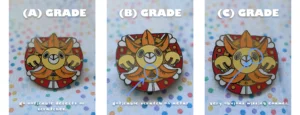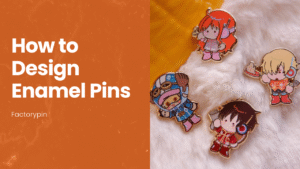Custom pins are a popular choice for promoting brands, commemorating events, or creating personalized accessories. But when it comes to highly detailed, small-scale artwork, the method you use to apply the design can make or break the final product. That’s where silk screen printing — also known as screen printing on enamel pins or printed enamel pin detailing — truly shines.
Here’s a quick video to explains it.
But if you want to understand how it works and why it’s such a game-changer for designers, this article dives deeper into the details that video can’t cover.
What Is Silk Screen Printing on Pins?
Silk screen printing is a surface printing method that applies ink directly onto the front of a pin. Unlike standard mold-based production, it doesn’t rely on metal borders to separate colors. Instead, it prints flat color shapes, outlines, and textures with extreme precision.

This technique is commonly used to add final details on top of hard enamel or soft enamel pins — especially for:
- Ultra-fine lines (hair strands, wrinkles, anime-style eyes)
- Small text or logos
- Background textures
- Decorative elements that don’t fit mold constraints
And because it prints on the top surface, it adds detail without changing the mold at all.
Why Use Silk Screen? A Quick Comparison
| Design Element | Molded Enamel | Silk Screen Printing |
|---|---|---|
| Minimum line width | ~0.2–0.3mm | 0.1mm (factory standard) |
| Text detail | Often limited | Crisp, even at tiny sizes |
| Background effects | Hard to mold | Easy to print flat textures |
| Multicolor overlays | Needs metal borders | No borders required |
| Cost impact | Mold cost can rise | Only charges per screen color |
For highly detailed enamel pin designs — especially those with fine line art, small font sizes, or crisp overlays — silk screen is your best friend. Our team consistently delivers 0.1mm line accuracy using precision mesh and UV-cured inks. For larger batches, we suggest 0.15–0.2mm for better durability.
Where and How It’s Applied
Silk screen is always used on the front of the pin and can be layered over:
- Hard enamel: Printed after polishing, for a clean and flat look
- Soft enamel: Printed within recessed areas, usually sealed with epoxy
- Bare metal zones: Possible, but we apply a protective coating to avoid scratches
We’ve worked with clients who thought their designs were too complex for enamel pins. Once we introduced silk screen printing, everything changed. Background gradients, anime-style faces, tiny logos — all of it came through crisp and clean.
And because our team is trained in combining print layers with special effects, we don’t just print — we plan around your entire pin production. That includes layout review, color matching, and factory-level alignment. You’re not just getting a technique; you’re getting support from start to finish.
Design Your Silkscreen Pins
Have an idea in mind? Let us turn your pin concept into reality — perfectly sized, beautifully made.



How It Works in Production
The silk screen process involves several controlled steps:
- Artwork separation: Each color layer is separated digitally
- Screen preparation: A fine mesh screen is prepared for each color
- Ink printing: Inks are pressed through the mesh onto the pin surface
- Curing: Each layer is heat- or UV-cured to fix the ink permanently

This adds only 1–2 days to our standard custom pin production timeline. And since it doesn’t require new molds, silk screen is a flexible and fast way to upgrade your design — even for small minimum orders.
Cost & Lead Time: What You Need to Know
| Item | Detail |
|---|---|
| Additional cost | Based on number of print colors (usually $1–5) |
| Production time | Adds ~1–2 days |
| Minimum order | Same as standard pins (e.g. 30 pcs) |
| Durability | Strong adhesion when cured and/or sealed |
| Compatibility | Works on hard enamel, soft enamel, or epoxy-sealed surfaces |
Common Questions from Our Clients
Can I simulate gradients or shadows with silk screen?
Yes — while true gradients aren’t possible, we can create a gradient-like feel using halftones or multi-layered solid colors. Our team can help optimize your artwork for this.
Will the print scratch off?
Not under normal use. We use high-quality industrial inks and either UV or heat curing. For added durability, especially on soft enamel, we recommend adding a clear epoxy layer.
How many colors can I silk screen?
We suggest keeping it under 5 colors per design for best results. Each color requires a separate screen layer, so we’ll advise based on your artwork.
How is it different from UV printing?
Good question — we’ve written a full blog explaining the difference between silk screen and UV printing, with real examples.
👉 Check out our comparison guide here
Want to Bring Your Details to Life?
Silk screen printing is a powerful way to keep your original design intact. Whether you’re producing merchandise for fans, clients, or collectors, this is the go-to technique for precision detail and vibrant results.
If you’re ready to take your design to the next level, let us help you figure out how silk screen can work for your next pin project — and whether it’s the right tool for your creative vision.





